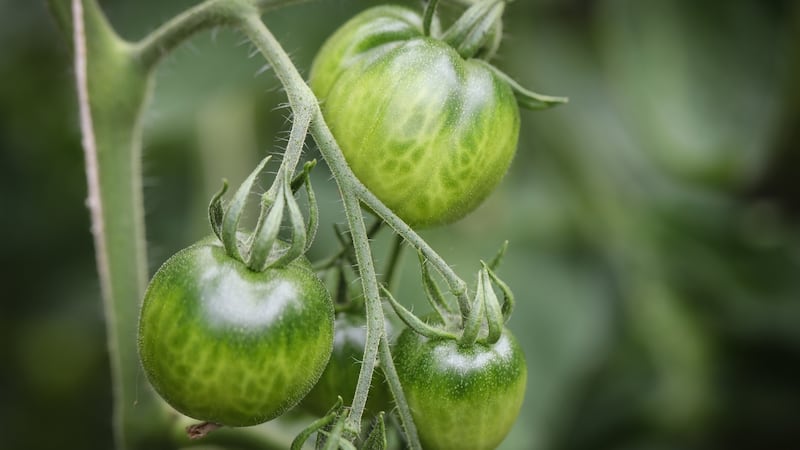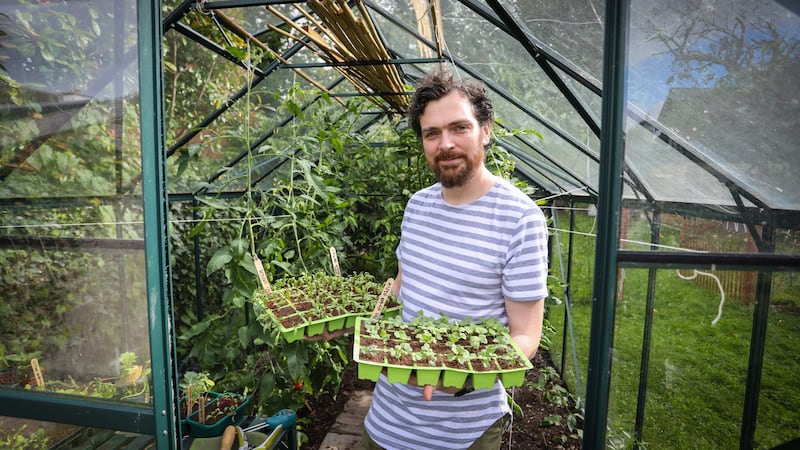Much like the neat 1940s bungalow to which it belongs, Adam Bermingham’s sunny back garden in suburban Dublin evokes a quieter, gentler age.
There’s a new small glasshouse (something he’d coveted for years) filled with ripening tomato plants and baby seedlings, two elderly apple trees whose ripened fruit sprinkles the lawn, and four new raised vegetable beds that he’s filled with carrots, potatoes, onions and leafy crops.
Young roses and wisteria scramble up the walls, lofty sunflowers tilt their blooms towards the light while there’s even a giant lime tree whose sloping branches beg to be climbed.
Striking a very 21st-century note, however, is the garden’s home weather station that Bermingham – a software engineer specialising in data science – recently installed so that he could more closely monitor the garden’s fluctuating microclimate throughout the growing season.

Its sensors measure humidity, wind speed, rainfall amounts and – perhaps most crucially from a gardener’s point of view – air temperature, feeding him regularly updated forecasts via his mobile phone.
For the weather-obsessed Bermingham, it’s like having his very own personal meteorologist.
“Remember that series of bad frosts back in very late spring? It alerted me to the fact that the temperature was plunging so I knew I had to protect the more tender plants in the glasshouse.”
Bermingham’s interest in gardening began in his 20s and has always been endearingly boffinish. Together with his wife Susan (then his girlfriend), he experimented with growing a variety of food crops on their windy Dublin apartment balcony, a tiny space that measured only eight square metres.
He evaluated yields, successes and failures, calculated the calories provided and compared the costs of compost, seeds and pots versus the savings made on food shopping, sharing his findings via a series of colourful graphs, pie tables, scatter plots and pie charts on his (now obsolete) blog EightSquareMetres.
When the couple bought their current home in Churchtown in 2017, they chose it as much for its large suburban garden as for the house itself, whose period charms they were determined to preserve.


“We’ve both always wanted to live in a bungalow. We just love that sort of west-coast America, mid-20th century architecture.”
With the help of an architect, they built a small single-storey extension and a secluded, sunny, courtyard garden whose redbrick walls and cast concrete beams are designed to mirror the distinctive period features of the original house.
After almost two years of renovation work, he, his wife and their two young daughters finally moved in at the beginning of 2019. What did it feel like to finally have their own proper garden?
“Very exciting, very interesting, but also a little bit overwhelming. Within a month I was out building the raised beds but there was so much to take in and it had been neglected for so long that there were times when I felt a little despairing. I would wonder ‘What if it all goes south? What if the weeds take over?’
“But the more I gardened, the more I was reminded that it was all about observing the basic principles of horticulture. So I started studying the way the light moved around the space to see which areas were shady, which were sunny, which were sheltered, which were exposed.
“I found out which areas of it were prone to being wet or waterlogged, which particular weeds were a problem – creeping buttercup and bindweed – and I’ve also been finding out a lot more about the garden’s soil type, which is sticky and prone to compaction.
“But probably the most valuable thing I’ve learned is to do the rounds each day. That way you really get to know the garden, are completely in tune with it and can easily intervene before a small problem becomes a larger one.”

Over the last two years Bermingham and his wife have transformed the long-neglected space, filling it with herbs and vegetables, carving out colourful flowerbeds and planting native hedging.
“Susan looks after the flowerbeds while I look after the raised vegetable beds, the herbs, the glasshouse and the grass.”
As befits the owner of a 1940s bungalow, he is a dedicated lawn lover. As befits a data scientist, he can also tell you that the total area that he mows (including the front) is 600sq m. As befits a modern organic gardener, he doesn’t spray it with a battery of weed and moss killers, content to let the dandelions and daisies grow.
"One of the best gardening books that I've bought is The Organic Lawn Care Manual by Neil Tukey, which gives lots of great advice."
Other invaluable garden reference books in his growing library include Sligo-based Klaus Laitenberger's Vegetables for the Irish Garden, Cork-based Joyce Russell's The Polytunnel Book and anything by the no-dig British organic gardening guru and writer Charles Dowding.

“The RHS [Royal Horticultural Society] practical guides are also excellent, especially their What Plant Where Encyclopaedia which is really clearly laid out and very easy to use. I’ve found it brilliant for help in choosing plants according to their growth habit, preferred growing conditions and colours.”
The internet and Instagram are, of course, other fertile sources of inspiration and information.
“Especially the feeds of gardeners growing in the same zone; it’s always fascinating to see how their growing seasons compare to my own garden’s.”
At the beginning of this year, shortly before the pandemic, Bermingham decided to take a short career break from his job to become a full-time homemaker and spend more time with his young daughters. Within a few months the country was in lockdown.
“Suddenly we were all at home all day,” he says.
He juggled childcare with the garden, plotting more projects with his wife including a contemporary flower border inspired by the work of designers such as Nigel Dunnett and Piet Oudolf, and a wildflower meadow that will curl its away around a circular lawn. Their lines and contours are already mapped out, the beds half dug. It's quite a project. Is he ever worried that he's taking on more than he can chew?
“It’s quite a lot of garden to look after, that’s true. But no, it’s not going to be a problem. I just love it far too much for that ever to happen.”
This Week in the Garden:
Start clearing away plants that have finished cropping in the kitchen garden and/or polytunnel to make way for follow-on crops as well as to help prevent a possible build-up of pests and diseases. If you’re not going to replant the free space straight away, then cover it with some sheets of cardboard or black plastic to prevent fresh weed growth.
There’s still plenty of time to take cuttings of a wide range of trees, shrubs, perennials, climbers and herbs to have plenty of new plants to share with gardening friends or to donate to charity plant sales.
Always use a clean sharp scissors or a secateurs to take the cutting material, immediately placing it into a plastic bag to which you’ve added a splash of clean water. Place this bag somewhere cool and out of direct sunshine until you’re ready to prepare the cuttings, which ideally should be as soon as possible.
Some of the many species suitable for propagating from semi-ripe cuttings taken at this time of year include hydrangea, artemisia, berberis, camellia, ceanothus, hebe, viburnum, escallonia, bay, lavender, rosemary, linaria, phlox, salvia, penstemon, passion flower, solanum and trachelospermum.
Dates For Your Diary:
Sunday, August 30th (10am-5pm), Farmleigh Autumn Plant Fair, Farmleigh, Phoenix Park, Dublin, Admission free.
The second plant fair of 2020, there will be a large selection of specialist nurseries selling a wide range of herbaceous perennials, shrubs and trees, and herbs as well as other exhibitors selling garden-related products. Social distancing and Covid-19 protocols will be in place.
For further information call 086 6045715.



















